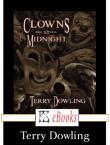AustLit
Latest Issues
AbstractHistoryArchive Description
'Troubled by coulrophobia, a lifelong fear of clowns, 41-year-old writer David Leeton goes to the north-eastern corner of New South Wales to mind a property for a friend. Not usually one to run away from his problems, David has just come out of a seven-year relationship with Julia, and needs time away from his old routines. House-sitting at Starbreak Fell seems the perfect solution.
'David is especially glad of his decision when he meets his neighbours, the charming and surprisingly well educated Risi family, Sardinian Australians who raise pigs in the area, even more so when he is introduced to one of their guests at dinner, the intriguing and increasingly beguiling Gemma Ewins.
'But David isn't at Starbreak Fell very long before strange things start to happen: glimpses of masked figures, voices calling in the night, terrifying images left on his computer, events disturbingly related to his special condition which draw him again and again to the mysterious stone tower on the forested hilltop behind the house.
'Clowns at Midnight is a powerful and spellbinding tale of fear and wonder, of unexpected transformations and genuine redemption. David's discoveries in this almost overlooked corner of rural Australia lead him full-square into both the universal mystery at the forgotten core of Western civilisation and the deepest, darkest secrets of the human heart.'
Source: Publisher's blurb.
Notes
-
PhD Thesis (Creative Writing), University of Western Australia.
Publication Details of Only Known VersionEarliest 2 Known Versions of
Works about this Work
-
The Australian Horror Novel Since 1950
2012
single work
criticism
— Appears in: Sold by the Millions : Australia's Bestsellers 2012; (p. 112-127) According to James Doig the horror genre 'was overlooked by the popular circulating libraries in Australia.' In this chapter he observes that this 'marginalization of horror reflects both the trepidation felt by the conservative library system towards 'penny dreadfuls,' and the fact that horror had limited popular appeal with the British (and Australian) reading public.' Doig concludes that there is 'no Australian author of horror novels with the same commercial cachet' as authors of fantasy or science fiction. He proposes that if Australian horror fiction wants to compete successfully 'in the long-term it needs to develop a flourishing and vibrant small press contingent prepared to nurture new talent' like the USA and UK small presses.' (Editor's foreword xii) -
The Field : Reviews
2011
single work
review
— Appears in: SF Commentary : The Independent Magazine About Science Fiction , June no. 81 2011; (p. 41)
— Review of Clowns at Midnight 2006 single work novel
-
The Field : Reviews
2011
single work
review
— Appears in: SF Commentary : The Independent Magazine About Science Fiction , June no. 81 2011; (p. 41)
— Review of Clowns at Midnight 2006 single work novel -
The Australian Horror Novel Since 1950
2012
single work
criticism
— Appears in: Sold by the Millions : Australia's Bestsellers 2012; (p. 112-127) According to James Doig the horror genre 'was overlooked by the popular circulating libraries in Australia.' In this chapter he observes that this 'marginalization of horror reflects both the trepidation felt by the conservative library system towards 'penny dreadfuls,' and the fact that horror had limited popular appeal with the British (and Australian) reading public.' Doig concludes that there is 'no Australian author of horror novels with the same commercial cachet' as authors of fantasy or science fiction. He proposes that if Australian horror fiction wants to compete successfully 'in the long-term it needs to develop a flourishing and vibrant small press contingent prepared to nurture new talent' like the USA and UK small presses.' (Editor's foreword xii)
- Far Northeast NSW, New South Wales,




